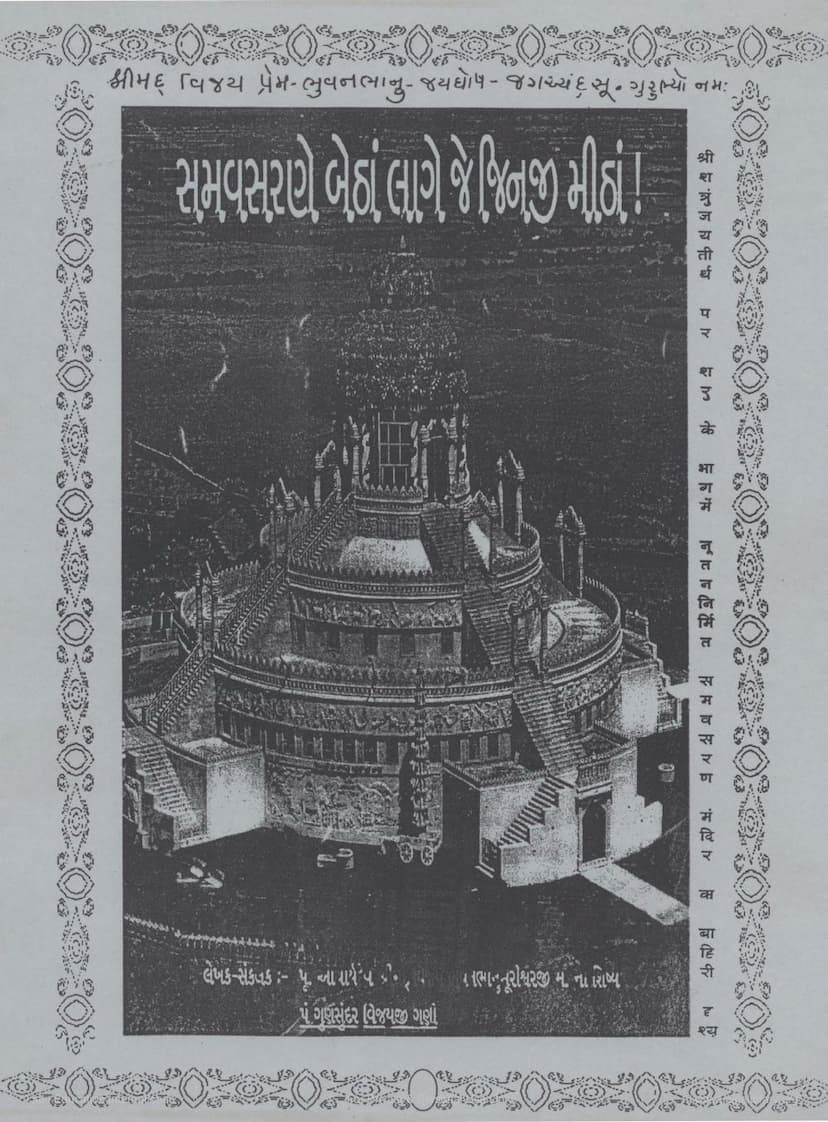Samavsarne Betha Lage Je Jinji Mitha
Added to library: September 2, 2025

Summary
This document, "Samavsarne Betha Lage je Jinji Mitha" (Meaning: "When seated in the Samavasarana, the Tirthankaras appear sweet"), authored by Acharya Bhuvanbhanusuri and compiled by Punyasagar Vijayji Gani, is a detailed exposition on the Jain concept of the Samavasarana. The Samavasarana is a divine assembly ground created by the gods for a Tirthankara (an omniscient being) to deliver spiritual discourses to all beings.
The book meticulously describes the structure and organization of this sacred space, covering various aspects:
1. The Construction of the Samavasarana:
- It begins with the divine construction of the Samavasarana, initiated by the gods. This involves purification of the land with a special wind, followed by a rain of fragrant water and flowers.
- The Samavasarana is characterized by three concentric ramparts or fortresses (Gadh).
- The innermost fortress is made of gems (ratna).
- The middle fortress is made of gold (kanaka/suvarna).
- The outermost fortress is made of silver (rupa).
- The crenellations (kangara) of these fortresses are also made of respective precious materials.
- Each fortress has four gates in each cardinal direction, totaling twelve gates for the entire Samavasarana.
- The gates are adorned with beautiful torans (arches) and banners (dhvaj).
2. The Divine Seating Arrangement (12 Parishada): The book elaborates on the seating arrangement for the twelve assemblies (Parishada) within the Samavasarana. These assemblies comprise various categories of celestial beings (Devas) and humans:
- Celestial Beings (Devas): Divided into eight types: Bhavanapati (dwelling-based), Vyantar (intermediate), Jyotish (luminous), and Vaimanika (celestial abode). Both male and female celestial beings are mentioned.
- Humans: Consist of four types: Sadhus (monks), Sadhvis (nuns), men, and women.
- The seating positions are meticulously described, with different assemblies occupying specific locations within the ramparts. For instance, Vaimanika deities, humans, and celestial beings are described as being in particular corners, with monks and nuns also having designated areas. Some assemblies are seated, while others, like Vaimanika Devi and Sadhvis, are described as standing.
3. The Arrival and Seating of the Tirthankara:
- The Tirthankara's arrival is a grand event, involving walking on lotus flowers created by the gods.
- Upon arrival, the Tirthankara circumambulates the Chaitya-vriksha (a sacred tree, usually an Ashoka tree) and sits on a bejeweled lion-throne, facing east.
- To represent the Tirthankara's omnipresence, three life-like effigies are created, seated on thrones, holding chamaras (fly-whisks), and chhatras (umbrellas). These effigies are placed in the other three directions, making it appear as though the Tirthankara is addressing everyone directly.
- The chief Gana-dharas (disciples who compile the Tirthankara's teachings) sit near the Tirthankara.
4. The Tirthankara's Discourse (Deshna):
- The Tirthankara delivers discourses (Deshna) based on the knowledge of beings who will attain liberation in that very lifetime.
- The teachings are universally understood, with the divine sound (Divya Dhwani) manifesting in the language of each listener. This divine speech is described as sweet, melodious, and capable of removing all doubts and fulfilling all desires of the listeners.
- The book highlights the miraculous nature of the Tirthankara's speech, emphasizing its power to simultaneously answer all questions and resolve the doubts of countless beings.
- It also explains the purpose of the Tirthankara's discourse, which is to guide beings towards spiritual liberation and adherence to dharma.
5. The Tirthankara's Divine Attributes:
- The text elaborates on the Tirthankara's unparalleled physical beauty and attributes, comparing them to a scale of perfection that far surpasses even the most beautiful celestial beings.
- It discusses the immense virtue (punya) accumulated in past lives that leads to the Tirthankara's glorious form and qualities.
- The Tirthankara's speech is further described as possessing several virtues, including being Sadharana (common to all), Asapatna (unequalled), and Grahika (knowledge-imparting).
6. The Role of Gana-dharas:
- After the first session of the Tirthankara's discourse, the Gana-dharas take over to continue the teachings.
- This is explained as a way for the Tirthankara to rest and to showcase the profound knowledge and spiritual stature of the disciples, reinforcing the authenticity and consistency of the teachings.
- The Gana-dharas are described as having the ability to recall past and future events across countless lifetimes and to answer even the most complex questions.
7. Acts of Devotion and Generosity:
- The book describes Vrittidan (maintenance donation) and Preetidan (donation out of affection), where kings and wealthy individuals make offerings to support the spread of the Tirthankara's teachings and honor those who announce the Tirthankara's arrival.
- These acts of generosity are seen as emulating the devotion of the gods and are believed to result in great merit and happiness.
8. The Structure and Dimensions:
- Detailed descriptions and measurements of the Samavasarana's structure are provided, including the height of the ramparts, the number of steps, and the overall dimensions in terms of Gau (a unit of measurement) and Yojana. It mentions that the Samavasarana is elevated above the ground and circular in shape.
- It also touches upon the concept of a square Samavasarana, with different dimensions.
9. Stuti (Praise):
- The book includes devotional verses (Stutis) praising the Tirthankara, the Tirthankara's divine speech, and the idols of the Tirthankara, emphasizing their role in dispelling suffering and bringing auspiciousness.
In essence, "Samavsarne Betha Lage je Jinji Mitha" serves as a comprehensive guide to understanding the divine audience hall of a Tirthankara, detailing its construction, the beings who attend, the spiritual discourse, and the inherent qualities of the Tirthankara and his teachings, all within the framework of Jain cosmology and philosophy.